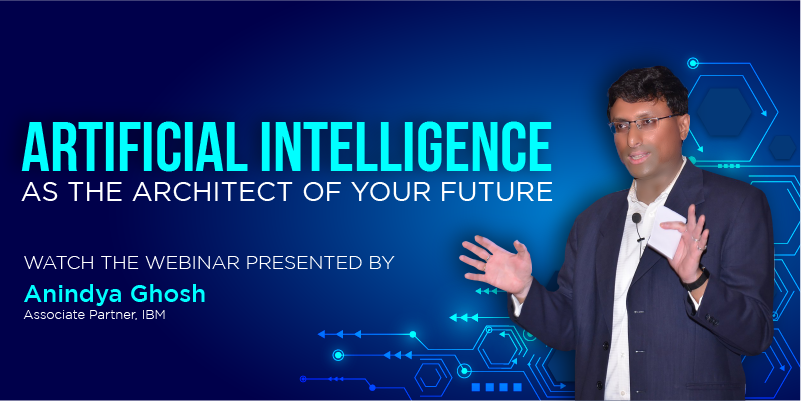Artificial Intelligence as the Architect of Your Future

Artificial Intelligence as the Architect of Your Future
AI technology has been around from 1970’s onwards and hence is not a new technology. Though there is a hype around implementing AI across domains and industries, most of the time required results are not achieved, due to the lack of good as the quality of the data.
What is Artificial Intelligence?
Artificial intelligence is the mirror image of natural intelligence present in the human brain. The human brain works based on different types of algorithms such as association algorithms, reasoning and knowledge assimilation etc. to build a similar AI system, the a set of building blocks need to be ready.
Big Data Technology
Big data technology plays a vital role in this data-driven world, which can harness the power of data but it cannot be used in computing power that is required. To overcome this hurdle, artificial intelligence comes handy.
Big data consists of all kinds of data, structured, semi structured and unstructured data collected from various social media, IOT devices, ERP systems, Videos Cameras and so on.
Today to build an AI system with cognitive abilities, building a foundational Big Data System is essential.
Natural Language Development
How our brain does create associations? How our brain does create logical reasoning? There are different ways through which our brain does these.
For example, a newborn baby will see and hear a lot of things since the day it was born. After a point of time, the baby will start learning a language based on its exposure to that language, whether it is English, Chinese, Japanese, or any other. To achieve this, the baby’s brain will analyze the things happening around and understand the way it is taught. Likewise, the brain is creating an association with each and everything felt by the baby. As the baby grows up, the brain keeps on adding more and more information to the repository. Then, the brain starts creating other associations by keeping one association as the foundation of knowledge. Thus, human beings learn with logical reasoning.
With logical reasoning, human beings develop inferences. From these inferences, humans develop associations. Similarly, many other things will be added to the entire knowledge spectrum of the human mind, which enable human minds to develop continuously.
In the same manner, human beings learn languages they use and can express their emotions in multiple languages. Over time, humans start developing empathy and then embark into knowledge discovery. The human brain follows a particular pattern to understand and analyze things.
So, what about the artificial brain?
In an artificial brain, algorithms are built by human beings based on the requirements. Multiple languages can be learned by this artificial brain such as Python, Java, Pyspark, etc. First all, it is mandatory to develop the ontology and taxonomies of the languages, and then the hierarchies of these languages are created to build an association with these languages.
Cognitive systems act just like human beings through understanding, reasoning, learning, and interacting.
Initially, cognitive systems understand imagery, language and other unstructured data like humans. Next level is reasoning in which the systems will grasp underlying concepts, hypotheses, infer, and extract ideas from their understanding. Then, learning happens in which they develop and sharpen their expertise. Learning is a never-ending process for the artificial brain as well. In the end, they will start interacting like humans by developing the abilities to see, talk and hear. This interaction will become the ultimate part of the machine learning systems.
Conversational Systems
Similar to human conversation, there are artificial intelligence conversational systems also. Chatbots and online chats are the primitive levels of conversational systems as they perform a basic level of conversation. As the human grows, the brain also evolves and acquire complex reasoning abilities. Similarly, artificial intelligence conversational systems also have to evolve to achieve more and more complex reasoning ability.
Is it possible for an artificial intelligence system to converse like a human?
For a human-like conversation, an AI system has to develop considered judgement depending on the context to have a contextual conversation. For e.g. a doctor only can prescribe a medicine for the patient based on the symptoms of the disease.
Today, the world needs such contextual conversational systems to be built in various domains. The artificial intelligence conversational systems have to be trained to prompt their learning capabilities. A business analyst will create the ontology and taxonomies to bridge the gap between subject matter experts and AI systems. Data scientists will come up with algorithms that can be added to these systems to enhance logical reasoning.
Problem-Solving Capabilities of AI
There are multiple types of problems that can be solved by AI such as email classification, language translation, visual inspection, optical character recognition, automated order creation, etc. AI systems can identify logos, watermarks, signatures and many such things within the document and extract them for creating a perfect document.
By bringing AI technology into various domains, every work can be made easier without much human intervention. It can transform the experience of internal (employees, buyers, and managers) and external personas (customers and vendors) by performing various services such as customer care, employee care, process assistant, and buyer assistant services. It can work as the brain of your organization as an equipment advisor, plant advisor, FAQ bots, and L2/L3 support.
Natural Language Processing
Like human language, natural language processing also has syntax. In NLP, not only keyword analysis is performed but also analyze how to use a keyword into the context of a sentence.
In contextual classification, classification of words is done based on the context. Why? Because a single word will have multiple meanings without adding a context. Hence, multiple classes are formed whenever a new element is added to the context. Then, AI will auto classify the information into one of these classes and understand the contextual meaning. This process is known as natural language processing.
How Can Machines Understand Language?
Machines have to transform unstructured data into structured data and organize the data for further analysis before it can be used for processing. There are multiple ways to do that. The machine identifies things using natural language processing, which allows them to understand the context and respond accordingly.
Generally, there are 5 steps in natural language processing such as lexical analysis, syntactic analysis (parsing), recognizing named entities, retrieving textual information, and classifying and clustering textual information. The structure of the words will be analyzed to recognize the parts of speech in lexical analysis. Each grammatical component of the sentence is broken down and analyzed whether it is conformed to the grammatical rules in syntactic analysis or parsing.
In a semantic analysis, the context of the language is analyzed to understand the right meaning of the words in a particular context. Then, the entities in the text have been extracted that help to classify them into predefined categories such as organizations, location, person names, quantities, medical codes, dates, etc.
Retrieval of textual information will be performed to facilitate the relevant search of data/documents based on the requirement of the users. Then, relevant data or text will be classified based on predefined classes. Clustering is used to identify the similarities between the words/texts based on their common characteristics and also how they differentiate each other.
The machine will thus understand the customer’s intent and guide them through the processes involved to provide the exact information.
Final Thoughts
Artificial Intelligence can perform any task without much human interference such as visual interpretation, decision-making, translating languages, drafting of the legal document, diagnose diseases, etc. In this digital world, a huge chunk of data has been generated in every other minute. AI increases the productivity of organizations and businesses and the demand for AI job roles will increase in time. Hence, obtaining AI skills is the best way to have future-proof careers.
AUTHORS




